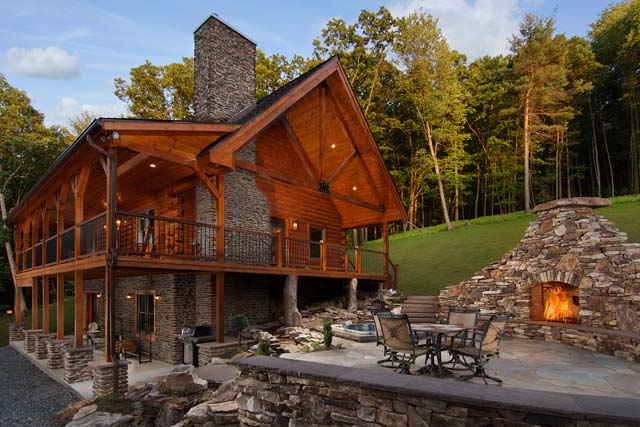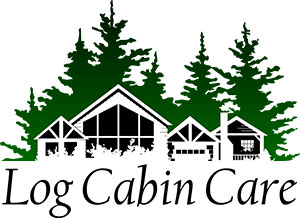
How To Care for Your Log Cabin
If you’re an owner of a log cabin or log home – or are contemplating purchasing a property that features a seasoned log structure – you may be asking yourself: How do I maintain these logs? Or how can I make this log home or log cabin look new again? Well, allow us to shed some light (no pun intended) and offer a few suggestions on this frequently asked question.
The methods and products mentioned herein are based on our own personal experiences and/or preferences. As in any home project, it is the responsibility of the homeowner to (a) determine if they are capable of doing this work, and (b) if these methods and materials are suitable for their particular situation. This can be done by thoroughly reading the manufacturer’s directions and/or testing the product or method first on an inconspicuous area on the home. If you determine that you are uncertain about whether or not you are capable of doing this work, contact a Log Cabin Care professional for assistance.
Log Cabin Care: Cleaning the Exterior
The first step to make your old log cabin or log home look new again is to clean the exterior – especially if the logs have become severely weathered or grey in color. By cleaning first, you can better assess the true condition of the logs and then establish what needs to be done and the materials needed.
There are several specialized chemical cleaners available to clean log cabins and log homes as you should never use a liquid bleach as it will damage the wood fibers. From our own experience, we have found two cleaners that yield very good results: CTA’s Outlast KleenStart or Sashco’s CPR Log Cleaner and Brightener.
Just follow the manufacturer’s instructions by dissolving the quart-sized cleaner in hot water and apply to the logs with a stiff nylon or bristle (not metallic) scrub brush. You can also use a roller or pump-up garden sprayer for application. (If you use a pressure washer, it is paramount to use a very wide angle nozzle (i.e. 40º), low pressure, and keep the nozzle at least 3-feet away from the wood. Failure to do so can result in damage to the logs.) Start at the bottom and work upwards. Wet down landscaping before and after the cleaning process. Refer to manufacturer’s instructions for complete instructions.
Cleaning the exterior of your log cabin or log home: Check!
The next step is to perform a visual inspection and address any Carpenter Bee nests. This applies to log home, log cabin and conventional homeowners alike. Read on for additional information. And remember, if at any point during this process, you feel these steps are too complex or you don’t feel capable of achieving the desired end result, please contact a Log Cabin Care professional for assistance.
Many thanks to our contributing editor, Art Hoffman, Authorized Sales Rep
Log Cabin Care: Visual Inspection and Addressing Carpenter Bee Nests
After you’ve successfully cleaned the exterior of your log cabin or log home, the next step is to perform an exterior visual inspection. Make a note of where you observe signs of the following:
- Carpenter Bee entry points
- Checks larger than ¼” wide
- The condition of caulking around windows, etc.
- Evidence of termites and their mud tunnels (Please note: If you observe any sign of termites, contact a licensed exterminator for treatment before proceeding further.)
Use the notes you’ve made as a checklist as you continue through this process. Remember, regardless of where you live or whether you are maintaining a log cabin, log home or a conventionally-sided home, you likely have experienced this dreaded insect at some time. This information pertains to ALL homeowners.
First, the “good news” – the Carpenter Bees that buzz around you in an aggressive manner are the males and they do not have stingers, so ignore them! (Easier said than done!)
Carpenter Bees generally prefer to drill their nesting holes in the fascia and soffit of houses as well as the underside of porch/deck handrails. The nesting holes are about 3/8” diameter and go into the wood about ¾” before making a 90-degree turn and continuing along for inches or feet, depending on the age of the nest. Within this “tunnel” are many, many egg chambers and (usually) the Queen (who can sting).
If you have a serious Carpenter Bee nest, you may also see chunks of wood at or along the hole. These are from woodpeckers, who are attracted to the nest by the bees “buzzing” and are “pecking for their next meal.” This is another reason that Carpenter Bees must be controlled!
Once you locate a hole, insert a length of nylon weed trimmer line into the hole as far as possible so that you puncture each chamber in the nest. Do this 2 or 3 times to ensure you have reached the furthest part of the nest and broken through each chamber. If you do not do this, the Carpenter Bees will not be stopped, merely deterred.
Next, while wearing a protective dust mask, fill the hole to the point of overflow with a safe insect deterrent such as Drione or Pyganic Dust. Each of these should be available from your local landscaping or garden supply store.
After 2-3 days, you might see dead Carpenter Bees or pupae laying on the ground below the hole. Continue with this step even if you do not see any bees or pupae, as the nest could still be active.
Next, repeat the trimmer line and insect deterrent step again to further ensure no activity is present in the nest and that all chambers have been punctured.
Wipe off any excess dust around the outside of the hole and about ½” into the hole. Using a suitable caulk that closely matches your stain color, such as Sika-Flex Log Home Tan or Sashco’s Conceal, seal the hole with caulking using a foam brush dampened in water to smooth it even with the wood surface. Allow the caulking to dry for at least 24 hours before continuing to the next step.
Viola’, you have defeated these culprits! Your log cabin or log home will be looking new again real soon. You’re about half way through the process. Way to go!
If you have questions or concerns along the way, please contact a Log Cabin Care professional for assistance.
